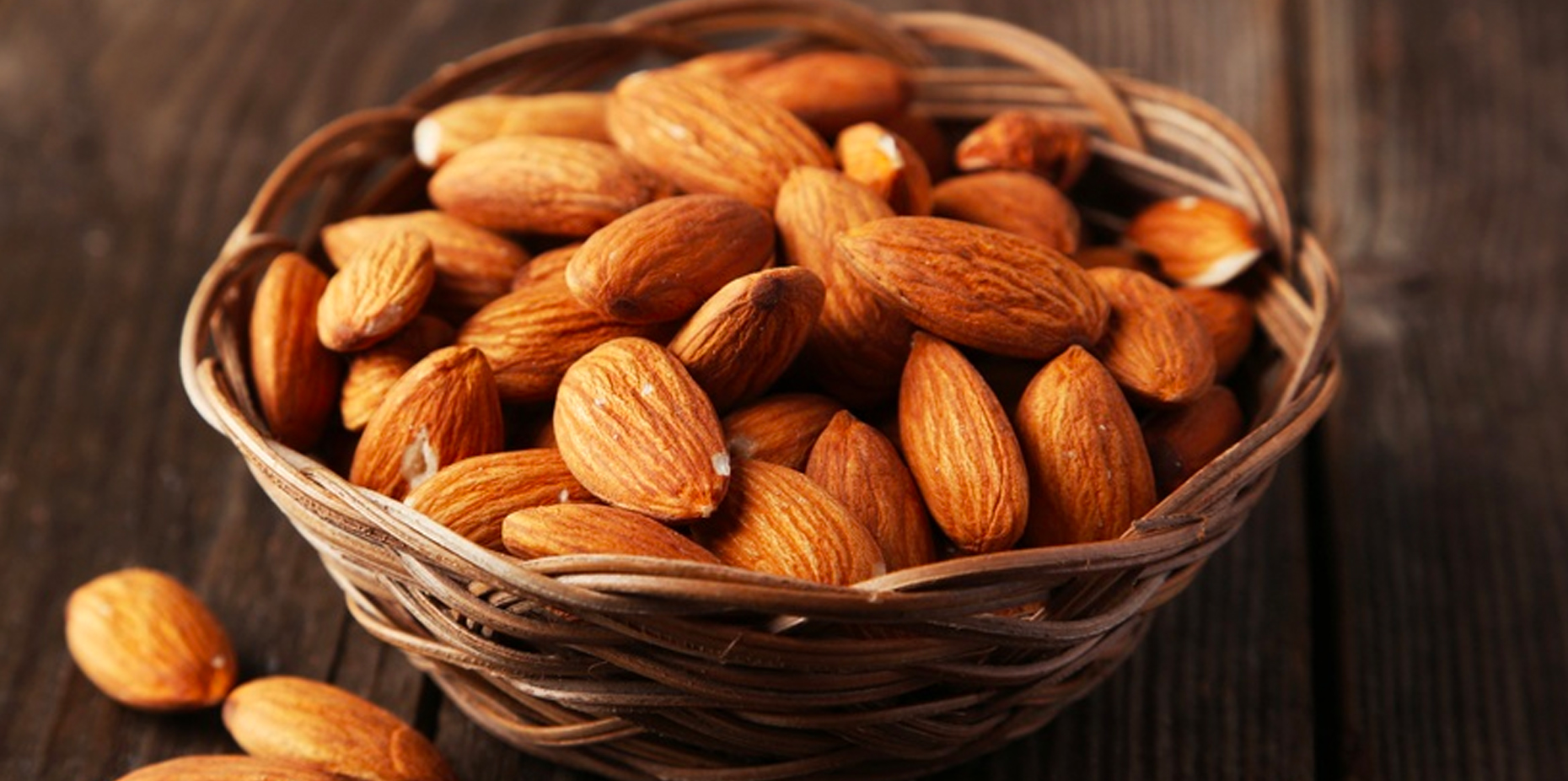Throughout the world, almonds are one of the most popular types of tree nuts there is.
They are rich, flavorful, and boast a ton of nutrients (1).
Not only that, they are high in healthy fats and protein and come with several health benefits from eating them (2).
Keep reading to find out all you need to know about almonds.
Did You Know?:Almond flour is a great alternative to wheat flour, especially for those looking for a great gluten-free option.
Table of Contents
History & Facts
The almond, Prunus amygdalus, comes from a tree that is native to the lands of Iran and its surrounding countries (3). The almonds that we eat are part of the edible seeds of the almond tree. There are many parts to the seed of the almond but the part that you see in stores is the already-shelled version. Although they look and taste very differently, almonds are very closely related to peaches. These two plant species are both a part of the Prunus genus along with plums, cherries, peaches, nectarines, and apricots.
Although almonds are native to the Middle East, the United States is now the world’s largest producer of them (4). They are also found in other parts of the world today in countries like Spain, Italy, and Australia.
Almonds have been enjoyed for centuries around the world. They were first mentioned in Greek mythology back in 1400-3000 BC and even talked about in the Bible. Almonds were also a big part of ancient Indians’ and Egyptians’ diets.
The edible almonds that are seen on the market are known as sweet almonds. The other kind, known as bitter almonds, is less edible and naturally contains toxic chemicals.
Fun Fact:Almond trees can grow as tall as 40 feet high and 12 inches wide.
Nutrition Facts
Almonds are nutrient powerhouses despite how small they are. They have one of the highest protein content of all nuts and contain a good amount of vitamin E as well.
Macronutrients
In one ounce (around 23 almonds, 28 grams weighed) of almonds, there are the following macronutrients (5):
- Calories: 164 calories (kcal)
- Protein: 6.01 grams (g)
- Total Fat: 14.1 grams (g)
- Saturated fat: 1.08 grams (g)
- Monounsaturated fat: 8.96 grams (g)
- Polyunsaturated fat: 3.49 grams (g)
- Carbohydrate: 6.12 grams (g)
- Fiber: 3.54 grams (g)
Almonds are high in protein and fiber (6). Both protein and fiber are known to increase feelings of fullness. This can help with feeling satiated and prevent overeating.
Research studies have even shown that eating a serving of almonds daily helped reduce hunger and the desire to eat and tie you over until your next meal (7). They are also high in healthy fats including mono- and poly-unsaturated fats (8).
Summary:Almonds are a great source of protein and fiber, both of which can help increase satiety and prevent overeating.
Vitamins and Minerals
In one ounce (around 23 almonds, 28 grams weighed) of almonds, there are the following vitamins and minerals (9):
- Calcium: 76.3 milligrams (mg)
- Iron: 1.05 milligrams (mg)
- Magnesium: 76.5 milligrams (mg)
- Phosphorus: 136 milligrams (mg)
- Potassium: 208 milligrams (mg)
- Folate: 12.5 micrograms (mcg)
- Choline: 14.8 milligrams (mg)
- Vitamin E: 7.26 milligrams (mg)
Almonds are a great source of magnesium (10). Magnesium is an important mineral that is part of several different metabolic processes in the body as well as blood pressure management (11).
Almonds are one of the largest food sources of Vitamin E (12).
Vitamin E is considered an antioxidant that is found within the structure of cell membranes in the body and helps to protect your cells from oxidative damage (13).
Studies have found correlations between increased vitamin E intake and decreased rates of heart disease, cancer, and Alzheimer’s disease.
Summary:Almonds contain several nutrients but are considered one of the highest in vitamin E and magnesium.
Health benefits
Let’s talk about the various health benefits that may occur when consuming an adequate amount of almonds.
May Promote Heart Health
Almonds have a positive effect on cholesterol levels, helping reduce the LDL lipoproteins in your blood, also known as “bad cholesterol” (14). This potentially reduces the risk of heart disease, as cholesterol is one of the main causes of cardiovascular problems.
Consuming almonds may help prevent LDL cholesterol from forming in the first place, which can help prevent inflammation and plaque formation in the arteries, also known as atherosclerosis (15).
Studies have shown that eating almonds five times a week reduces the risk of a heart attack by a substantial amount. Let’s not forget that almonds are rich in vitamin E, which also contributes to reducing the risk of heart disease.
Studies have shown that almonds increase the amount of antioxidants in the bloodstream, reducing blood pressure and improving blood flow (16).
Summary:Almonds may have a variety of positive effects on heart health, including decreasing plaque buildup, lowering cholesterol levels, improving blood flow, and more.
May Promote Skin Health
The Egyptian Queen Cleopatra was famous for her beautiful looks. Almonds were said to be part of her diet and skincare routine.
She might have been onto something because almonds are rich in vitamin E. Vitamin E is one of the most powerful antioxidants, nourishing the skin (17).
You can apply almond oil and milk to the skin to protect against damage caused by sun exposure. More than that, you can add almonds to your diet to help your skin keep its elasticity and softness.
Almonds might be your anti-aging beauty secret as well. Thanks to their high content of vitamin E, almonds prevent the cells in your body from premature aging. Moreover, they help boost the production of natural collagen in your body. So, you might want to listen to Cleopatra and add almonds to your list, right?
Summary:Because almonds are high in vitamin E, eating them may have a positive effect on skin health and protect against environmental damage and aging.
May Help Regulate Blood Sugar Levels
Almonds are a diabetes-friendly food that can reduce glucose and insulin levels after meals. So, snacking on almonds is almost always a good idea.
According to a 2010 study, eating almonds could significantly increase insulin sensitivity in people with a predisposition to diabetes (18).
Moreover, almonds are rich in healthy fats, protein, and fiber; not to mention their insanely high content of magnesium.
What is interesting is that magnesium is involved in more than 300 body processes, especially blood sugar control. What is even more interesting is that 25%- 38% of people with type 2 diabetes are deficient in magnesium (19). So, correcting this deficiency could significantly improve insulin function.
Therefore, magnesium-rich foods may help prevent type 2 diabetes or other metabolic syndromes.
Summary:Eating almonds has been associated with regulating blood sugar levels and increasing insulin sensitivity, which may be helpful for those with type 2 diabetes.
Ways to Consume
There are tons of ways to fit almonds into almost any diet. Keep in mind they are extremely flavorful on their own. To some, they are considered the world’s most perfect snack due to their subtle, buttery flavor.
Here are some ideas for incorporating them more into meals, snacks, and even beverages:
-
- Sliver almonds on top of yogurt or cereal
- Top on your favorite oatmeal
- Incorporate into baked goods like cakes, muffins, or scones
- Roll cookies into crushed almonds for a crunchy and healthy bite
- Mix them into any smoothie
- Add almond butter to toast
- Use as a substitute for peanut butter with celery or apples
- Mix them with other nuts for a flavorful snack
- Make trail mix with them
- Grind down and add to a delicious basil almond pesto
- Roast them with added seasonings on top
- Try almond milk
- Almond oil in place of cooking oil or olive oil
- Substitute almond flour for wheat flour
- Use them as a healthy and gluten-free alternative to bread crumbs
Did You Know?:80% of the world’s almonds are grown in California and no other state in the US grows them commercially.
Potential Risks
- Allergy: Since almonds are considered tree nuts, it is important to avoid almonds due to allergy risk (20). Tree nuts are one of the most common allergens. They typically affect a small percentage of people but reactions to them can range from mild to severe. Allergic reaction symptoms can include nausea, vomiting, lip or throat swelling, itchy skin, hives on the skin, tingling of the throat and mouth, and even throat swelling.
- Phytic Acid: Almonds contain something called anti-nutrients, specifically phytic acid. The reason it is considered an anti-nutrient is because it binds to important minerals and inhibits absorption into the body (21). So, with the phytic acid being present it is harder to get all of the benefits of the nutrients in the food. For almonds, this includes minerals iron, zinc, calcium, magnesium, and manganese.
- Weight gain: Although several studies out there have found almonds to be a food that helps weight loss, they can still affect body weight. This is because they are high in calories which can lead to weight gain when they are consumed in large amounts (22).
Summary:In general, almonds are safe to consume for most people. However, they can have an anti-nutrient effect, cause allergic reactions in some, and if they are overly consumed can cause weight gain for some.
Frequently Asked Questions
What is considered a serving size of almonds?
One serving of almonds is around ¼ cup (1 ounce), 28-30 or so almonds (23). For most, this equates to a small handful. This may seem like a small amount, however, they are so full of fiber and protein that they are likely to make you feel more full than you would think.
Why do almonds seem expensive compared to other foods?
The process of cultivating almonds is quite extensive. Therefore, the work involved to get them ready to eat causes them to be costly. The trees also require a lot of water to yield enough almonds for production. Almonds, however, are one of the cheapest compared to most other nuts.
How Should I Store Almonds?
Almonds are best stored in cool and dry conditions. The optimal goal of the recommended storage conditions is to maintain a low moisture environment, which helps preserve shelf life. They can also be stored in the refrigerator if desired. Overall almonds are a very shelf-stable nut. Almonds can have more than two years of shelf life when stored at the recommended conditions.
Did You Know?: Almond trees are the oldest domesticated trees in the world.
Conclusion
Almonds are tasty, inexpensive compared to other nuts, and are an easy addition to foods and as a snack on their own. They are one of the oldest domesticated trees around. Today, California leads the world with growing 80% of the world’s production of them.
Not only that, but they contain a ton of nutrients and may have several health benefits by consuming them. They are high in protein, fiber, minerals, and vitamin E. They may promote heart health, and healthy skin, and can help regulate blood sugar levels.
You’re missing out if you don’t already have almonds as a staple in your diet. Pick some up and see for yourself.












